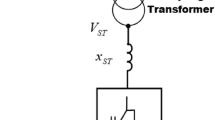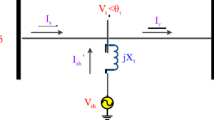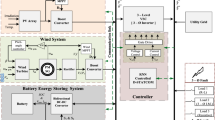Abstract
Medium voltage grids are subject to a change in load situation due to the installation of decentralized generation plants. Predominantly load symmetry, active and reactive power as well as the required capacity of earth fault compensation are affected. Inverter-based plants as well as consumers using switching power supplies or phase control cause distortions of frequency. Simultaneously, electrical energy storage is gaining importance within rural distribution networks to compensate fluctuating generation plants. A hybrid compensation system includes a transformer, a multi-phase inverter, diverse storage systems and a communication-capable control unit, which may be connected to the control center of the distribution system operator (DSO). It is object to current research activities to design and evaluate the functions of the superordinate control unit, which has to parametrize individual components, coordinate the energy flows between them and to embed several measuring instruments. Within the present work, basic considerations for design of system control are outlined.






Similar content being viewed by others
References
Bakon T (2008) Einsatz von Stromrichtern in der Energieversorgung zur Netzstützung und Fehlerstromlöschung, PhD thesis, Ruhr-Universität Bochum, Fakultät für Elektrotechnik und Informationstechnik
Hosemann G (2000) Elektrische Energietechnik. Springer-Verlag, Heidelberg
Sankaran C (2002) Power quality. CRC Press LLC, Boca Raton
Gustavsson R, Hussain S, Saleem A (2013) Ancillary services for smart grids—power quality markets. Ind Info Control Syst (ICS), Stockholm
Ise T, Hayashi Y, Tsuji K (2000) Definitions of power quality levels and the simplest approach for unbundled power quality services. Harmonics and Quality of Power, 2000. Proceedings. Ninth International Conference on, Orlando, FL, 2000, pp 385–390 vol.2
Gangl H (2001) Kann man Spannungsqualität kaufen?, e&i Elektrotechnik und Informationstechnik, Volume 118, Issue 9, pp 441–444
Berger M, Brauner G (2006) Zukünftige Tendenzen der Spannungsqualität in elektrischen Verteilnetzen. e&i Elektrotechnik und Informationstechnik 123(1–2):28–33
VDN-TransmissionCode (2007) Netz-und Systemregeln der deutschen Übertragungsnetzbetreiber, Berlin
Braun M (2009) Provision of ancillary services by distributed generation. Kassel University Press, Kassel
Kühn HJ, Salzmann JM, Mayer T et al (2008) Technische Richtlinie: Erzeugungsanlagen am Mittelspannungsnetz. Technischer Bericht, Bundesverband der Energie und Wasserwirtschaft BDEW
Keil T (2009) Schutzsysteme für elektrische Energieversorgungsnetze mit dezentralen Stromerzeugungsanlagen. Shaker Verlag, Aachen
Bronstein IN, Semendjajew KA, Musiol G, Mühlig H (2001) Taschenbuch der Mathematik. Verlag Harri Deutsch, Thun und Frankfurt am Main
Häfner J (1999) On the reduction of harmonics in power systems—a new hybrid power filter approach, Fachbereich 12—Elektrotechnik—der Technischen Universität Berlin
Sabin D, Brooks D, Sundaram A (1999) Indices for assessing harmonic distortion from power quality measurements: definitions and benchmark data. IEEE Trans Power Delivery 14(2)
Barth H, Hidalgo D, Pohlemann A, Braun M, Hansen LH, Knudsen H (2013) Technical and economical assessment of reactive power provision from distributed generators: case study area of East Denmark, PowerTech (POWERTECH), 2013 IEEE Grenoble. Grenoble 2013:1–6
Scherer M, Sattinger W (2010) Test zur Schwarzstart- und Inselbetriebsfähigkeit“, swissgrid AG, Frick
Prillwitz F, Krüger M (2007) Netzwiederaufbau nach Großstörungen“. Universität Rostock, Institut für Elektrische Energietechnik, Rostock
Asiminoaei L, Blaabjerg F, Hansen S (2005) Evaluation of harmonic detection methods for active power filter applications. Twentieth Annual IEEE Applied Power Electronics Conference and Exposition, 2005. APEC 2005., 2005, pp. 635-641 Vol. 1
Henao H, Assaf T, Capolino GA (2003) The discrete Fourier transform for computation of symmetrical components harmonics. Power Tech Conference Proceedings, 2003 IEEE Bologna, 2003, pp 6 Vol. 4
Srianthumrong S, Sangwongwanich S (1998) An active power filter with harmonic detection method based on recursive DFT, Harmonics and Quality of Power Proceedings, 1998. Proceedings. 8th International Conference On, Athens, 1998, pp. 127-132 vol.1
Hartley R, Welles K (1990) Recursive computation of the Fourier transform. Circ Syst 1990. IEEE International Symposium on, New Orleans, LA, 1990, pp 1792–1795 vol. 3
Allmeling J (2001) Schnelle Regelung eines Aktivfilters mit niedriger Taktfrequenz für das Mittelspannungsnetz. ETH Diss. 14428, Zürich, 2001
Allmeling JH (2002) A control structure for fast harmonics compensation in active filters. Power Electronics Specialists Conference, 2002. pesc 02. 2002 IEEE 33rd Annual, 2002, pp 376–381 vol. 1
Allmeling J, Stemmler H (2001) A fast current control technique for active filters with low switching frequency, Industrial Electronics Society, 2001. IECON ’01. The 27th Annual Conference of the IEEE, Denver, CO, 2001, pp 1125–1131 vol. 2
Bernet S (2012) Selbstgeführte Stromrichter am Gleichspannungszwischenkreis. Springer-Verlag Berlin Heidelberg
Komrska T, Peroutka Z, Matuljak I (2014) A novel least norm-based PWM for a four-leg earth fault compensator. IECON 2014–40th Annual Conference of the IEEE Industrial Electronics Society. Dallas, TX 2014:1118–1123
Kim Jang-Hwan, Sul Seung-Ki, (2004) A carrier-based PWM method for three-phase four-leg voltage source converters. In: IEEE Transactions on Power Electronics, vol. 19, no. 1, pp 66–75
Kim JH, Sul SK, Enjeti PN (2008) A carrier-based PWM method with optimal switching sequence for a multilevel four-leg voltage-source inverter. In: IEEE Transactions on Industry Applications, vol. 44, no. 4, pp 1239–1248
Glasberger T, Komrska T, Peroutka Z (2014) A minimum infinity norm based PWM modulator for four-leg three-phase converters, IECON 2014–40th Annual Conference of the IEEE Industrial Electronics Society. Dallas, TX 2014:1053–1059
San Martín JI, Zamora I, San Martín JJ, Aperribay V, Eguía P (2011) Energy storage technologies for electric applications. International Conference on Renewable Energies and Power Quality (ICREPQ’11), Las Palmas de Gran Canaria
Böhm R, Bürner J, Franke J (2015) Smart factory meets smart grid: cyber-physical compressed air systems enable demand side management in industrial environments. Appl Mech Mat 805, Nr., S. 25—31
Acknowledgments
The authors would like to express their sincere gratitude to the organizing committee of the conference iSEneC 2016—Integration of Sustainable Energy Conference.
Author information
Authors and Affiliations
Corresponding author
Rights and permissions
About this article
Cite this article
Böhm, R., Rehtanz, C. & Franke, J. Inverter-based hybrid compensation systems contributing to grid stabilization in medium voltage distribution networks with decentralized, renewable generation. Electr Eng 98, 355–362 (2016). https://doi.org/10.1007/s00202-016-0425-y
Received:
Accepted:
Published:
Issue Date:
DOI: https://doi.org/10.1007/s00202-016-0425-y




